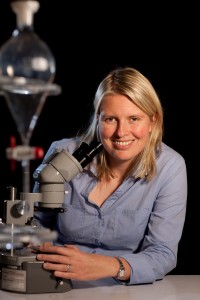
Archives
Tiny particles could assist in breast cancer screening

Blood tests using nanoparticles carrying molecules which can detect breast cancer biomarkers could save millions of lives and open the way to mass screening for many cancers.
Prof. Matt Trau, of the Australian Institute for Bioengineering & Nanotechnology at the University of Queensland, and his team are using a combination of nanotechnology and molecular biology in the project, funded by a five-year $5 million grant from the National Breast Cancer Foundation.
Continue reading Tiny particles could assist in breast cancer screening
Reading the hidden clock in a grain of sand

Dr Zenobia Jacobs wants to know where we came from, and how we got here. When did our distant ancestors leave Africa and spread across the world? Why? And when was Australia first settled?
Continue reading Reading the hidden clock in a grain of sand
Seeing things that no one ever knew were there!

A new $1.5 million super resolution microscope is producing spectacular images of bacteria and parasites, and making Australia a world leader in microscopy.
The DeltaVision OMX 3D-Sim Super-Resolution Microscope, recently acquired by the University of Technology, Sydney (UTS), is one of only two in the world.
Continue reading Seeing things that no one ever knew were there!
Australia’s place in the nanotechnology race

“Nanotechnology is not an industry—it is an enabling technology,” says Clive Davenport, leader of CSIRO’s Future Manufacturing Flagship.
Continue reading Australia’s place in the nanotechnology race
Eucalypts: the fuel of the future

Up to 30 per cent of the fuel needed for Australia’s road transport and the aviation industry could be generated through biofuels, creating tens of thousands of jobs and adding $5 billion to Australia’s economy.
And one of the prime sources of biofuel, according to Southern Cross University’s Centre for Plant Conservation Genetics, could be eucalypts.
How astronomy freed the computer from its chains

When you use a Wi-Fi network—at home, in the office or at the airport—you are using patented technology born of Australian astronomy.
Australia’s CSIRO created a technology that made the wireless LAN fast and robust. And their solution grew out of 50 years of radio astronomy and one man’s efforts to hear the faint radio whispers of exploding black holes.
Continue reading How astronomy freed the computer from its chains
How did we get here?
Zenobia Jacobs
University of Wollongong
Zenobia Jacobs wants to know where we came from, and how we got here. When did our distant ancestors leave Africa and spread across the world? Why? And when was Australia first settled?
These are difficult and controversial questions. But Zenobia has a deep understanding of time and how to measure it. She has developed a way of accurately dating when individual grains of sand were buried with human artefacts. And that technique is transforming our understanding of human evolution.
Big ecology: From tundra to savanna
Why are some plant seeds very small and others large? Angela Moles tackled this simple question by compiling information on 12,669 plant species. She discovered that plant seeds in the tropics are, on average, 300 times bigger than seeds in colder places like the northern coniferous forests. She then used these data to follow the evolutionary history of seed size over hundreds of millions of years.

The study was the first of its kind and the results, published in Science and PNAS, have revolutionised our understanding of the factors that determine the size of offspring in plants and animals. Angela is a leader in developing a new approach to ecology—one that could allow us to accurately model and predict the impact of climate change on ecosystems.
Continue reading Big ecology: From tundra to savanna
Could Vitamin D have a role in diabetes?
On Mondays, Jenny Gunton sees diabetes patients at Sydney’s Westmead Hospital. And from Tuesday to Friday, she heads up a diabetes research laboratory at the Garvan Institute of Medical Research. She’s also the mother of two-and-a-half-year-old “Action Boy”.

Gunton is one of a growing band of physician-scientists. “It’s not a financially sensible decision, but I enjoy it,” says Gunton. “It’s also a better way for me to ask questions and attempt to answer them. And in that way, I help my patients.”
And now, with the help of her L’ORÉAL Australia For Women In Science Fellowship she will be exploring the link between Vitamin D and diabetes.

